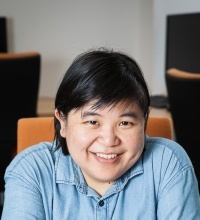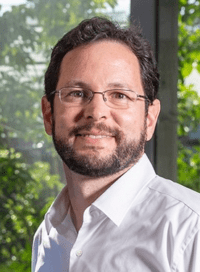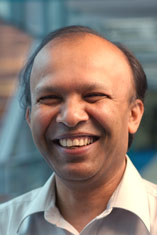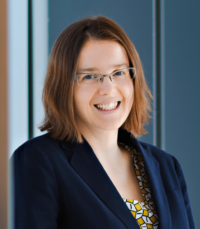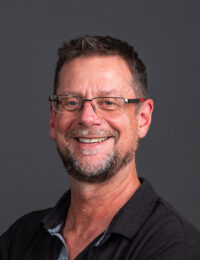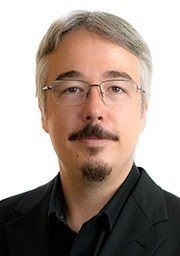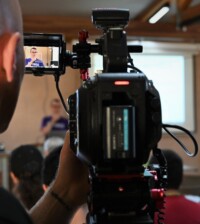-

Hanna Kurniawati
Australian National University
Hanna Kurniawati is an “ANU Futures Fellow” and Associate Professor at the Australian National University (ANU). She earned a PhD in Computer Science from National University of Singapore for work on robot motion planning. Her current research focuses on the design and development of algorithms to enable mathematically principled concepts for robust decision making to become practical tools in robotics. Together with colleagues and students, she won a best paper award at ICAPS’15 and was a finalist of the best paper award at ICRA’15. She was also a keynote speaker at IROS’18.
Talk title: Robust Decision-Making and Motion Planning
Uncertainty is ubiquitous. Despite this, a robot must decide what to do now to achieve good long term outcomes. This session will explore the available computational techniques for decision making and motion planning in non-deterministic and partially observable world. Specifically, we will focus on techniques that quantify uncertainty, such as Markov Decision Processes and its partially observable version. We will look into problem modelling, planning techniques, and the combination of planning and learning when the model of the problem is incomplete or unknown a priori.
-

Fabio Ramos
University of Sydney
Fabio Ramos is a Professor in robotics and machine learning at the School of Computer Science, University of Sydney, where he leads the Learning and Reasoning Group. He is also a Principal Research Scientist at NVIDIA, working on the connections between statistical machine learning and robotics. He received the BSc and MSc degrees in Mechatronics Engineering at University of Sao Paulo, Brazil, in 2001 and 2003, respectively, and the PhD degree at the University of Sydney, Australia, in 2008. His research focuses on statistical machine learning techniques for large-scale data fusion and decision making with applications in robotics, mining, environmental monitoring and healthcare. He has over 130 peer-review publications and received Best Paper Awards at IROS, ECML, ACRA and Best Paper Finalist at RSS.
-

Gamini Dissanayake
University of Technology Sydney
Gamini Dissanayake is the James N Kirby Distinguished Professor of Mechanical and Mechatronic Engineering at University of Technology, Sydney (UTS). He graduated in Mechanical/Production Engineering from the University of Peradeniya, Sri Lanka, received his M.Sc. in Machine Tool Technology and Ph.D. in Mechanical Engineering (Robotics) from the University of Birmingham, England. He taught at University of Peradeniya, National University of Singapore and University of Sydney before joining UTS in 2002. At UTS, he founded the UTS Centre for Autonomous Systems; currently a team of ninety staff and students working in Robotics. His main contribution to robotics has been in robot navigation, which has resulted in one of the most cited journal publications in robotics. He has also been involved in developing robots for a range of industry applications including cargo handling, mining, infrastructure maintenance and aged care.
Talk title: Simultaneous Localisation and Mapping
Robot navigation in unknown environments, particularly when an external location reference such as a global positioning system [GPS] is not available, requires a robot to be able to build a map of the environment in real-time and simultaneously estimate its own location within the map. Robust solutions to the “Simultaneous Localization and Mapping (SLAM)” problem, therefore, underpin successful robot deployment in many application domains such as urban search and rescue, underground mining, underwater surveillance, autonomous driving and planetary exploration. The SLAM problem has revealed many surprises since the first “solutions” emerged in the late 90’s. This talk will provide a somewhat biased history of SLAM drawing on my work with colleagues at University of Technology Sydney and University of Sydney over the past twenty five years. It will provide some insights into the key properties of the SLAM problem and its solutions based on extended Kalman filters, information filters, non-linear optimisers, graph theory and linear least-squares.
-

Dana Kulić
Monash University
Dana Kulić received the combined B. A. Sc. and M. Eng. degree in electro-mechanical engineering, and the Ph. D. degree in mechanical engineering from the University of British Columbia, Canada, in 1998 and 2005, respectively. From 2006 to 2009, Dr. Kulić was a JSPS Post-doctoral Fellow and a Project Assistant Professor at the Nakamura-Yamane Laboratory at the University of Tokyo, Japan. In 2009, Dr. Kulić established the Adaptive System Laboratory at the University of Waterloo, Canada, conducting research in human robot interaction, human motion analysis for rehabilitation and humanoid robotics. Since 2019, Dr. Kulić. is a professor at Monash University, Australia. Her research interests include robot learning, humanoid robots, human-robot interaction and mechatronics.
-

Peter Corke
Queensland University of Technology
Peter Corke is a robotics researcher and educator. He is the distinguished professor of robotic vision at Queensland University of Technology, director of the ARC Centre of Excellence for Robotic Vision and Chief Scientist of Dorabot. His research is concerned with enabling robots to see, and the application of robots to mining, agriculture and environmental monitoring. He created widely used open-source software for teaching and research, wrote the best selling textbook “Robotics, Vision, and Control”, created several MOOCs and the Robot Academy, and has won national and international recognition for teaching including 2017 Australian University Teacher of the Year. He is a fellow of the IEEE, the Australian Academy of Technology and Engineering, the Australian Academy of Science; former editor-in-chief of the IEEE Robotics & Automation magazine; founding editor of the Journal of Field Robotics; founding multi-media editor and executive editorial board member of the International Journal of Robotics Research; member of the editorial advisory board of the Springer Tracts on Advanced Robotics series; recipient of the Qantas/Rolls-Royce and Australian Engineering Excellence awards; and has held visiting positions at Oxford, University of Illinois, Carnegie-Mellon University and University of Pennsylvania. He received his undergraduate and masters degrees in electrical engineering and PhD from the University of Melbourne.
-

Tom Drummond
Monash University
Professor Drummond is a Chief Investigator based at Monash. He studied a BA in mathematics at the University of Cambridge. In 1989 he emigrated to Australia and worked for CSIRO in Melbourne for four years before moving to Perth for his PhD in Computer Science at Curtin University. In 1998 he returned to Cambridge as a post-doctoral Research Associate and in 1991 was appointed as a University Lecturer. In 2010 he returned to Melbourne and took up a Professorship at Monash University. His research is principally in the field of real-time computer vision (ie processing of information from a video camera in a computer in real-time typically at frame rate), machine learning and robust methods. These have applications in augmented reality, robotics, assistive technologies for visually impaired users as well as medical imaging.
-

Robert Mahony
Australian National University
Robert Mahony is a Professor in the Research School of Engineering at the Australian National University. He received his BSc in 1989 (applied mathematics and geology) and his PhD in 1995 (systems engineering) both from the Australian National University. He is a fellow of the IEEE and was president of the Australian Robotics Association from 2008-2011. His research interests are in non-linear systems theory with applications in robotics and computer vision. He is known for his work in aerial robotics, geometric observer design, matrix subspace optimisation and image based visual servo control.
-

Ian Reid
University of Adelaide
Ian Reid is an Australian Laureate Fellow, Fellow of the Australian Academy of Technological Sciences and Engineering (ATSE), former Rhodes Scholar, and Professor of Computer Science at the University of Adelaide. He is the Centre’s Deputy Director, University of Adelaide Node Leader and leader of the Semantic Representations research program. His research interests range across computer vision and are currently focused on life-long visual learning, and developing high-level representations for image and video understanding, especially those that can be computed and queried sufficiently rapidly to enable real-time robotic decision making and control. He has previous published widely in areas such as active vision, visual SLAM, visual geometry, human motion capture and intelligent visual surveillance. He has published over 293 papers on these topics in major journals and refereed conferences, has more than 16,000 citations and a h-index of 65. He is a member of the Australian Academy of Science (AAS) National Committee for Information and Communication Sciences, Interim co-chair for the AAS Future of Autonomous Systems, and General Chair for the 14th Asian Conference on Computer Vision (ACCV) to be held in Perth, Australia in December 2018. He has previously served on the editorial boards of IEEE T-PAMI, Computer Vision and Image Understanding, and Image and Vision Computing Journal, and has led a number of EU, UK and Australian Research Council sponsored research projects. He was the driving force behind the Centre’s successful LIEF (Linkage Infrastructure Equipment and Facilities) grant awarded by the Australian Research Council in 2016 for a new deep learning supercomputer to power the Centre needs to train deeper and larger models and to handle large numbers of parameters and big data.
-

Donald Dansereau
Local Chair
University of Sydney
Dr Donald Dansereau is a senior lecturer in the School of Aerospace, Mechanical and Mechatronic Engineering, and the Perception Theme Lead for the Sydney Institute for Robotics and Intelligent Systems. His work explores how new imaging devices can help robots see and do, encompassing the design, fabrication, and deployment of new imaging technologies. In 2004 he completed an MSc at the University Calgary, receiving the Governor General’s Gold Medal for his pioneering work in light field processing. In 2014 he completed a PhD on underwater robotic vision at the Australian Centre for Field Robotics, followed by postdoctoral appointments at QUT and Stanford University. Donald’s industry experience includes physics engines for video games, computer vision for microchip packaging, and chip design for automated electronics testing.
-

Previous International Speakers
2020
Tobi Delbruck (ETH Zurich and The Institute of Neuroinformatics, Zurich)
Stefan Leutenegger (Imperial College London)
Donald Dansereau (University of Sydney)2019
Laura Leal-Taixé (Technical University of Munich)
Seth Hutchinson (Georgia Institute of Technology)
Jose Neira (University of Zaragoza)
Silvere Bonnabel (Mines ParisTech)
Tarek Hamel (University of Nice Sophia Antipolis)2018
Margarita Chli (ETH Zurich)
Vincent LePetit (University of Bordeaux)
Yarin Gal (University of Oxford)
Andrea Cherubini (University of Montpellier)2017
Davide Scaramuzza (University of Zurich)
Simon Lucey (Carnegie Mellon University)
Javier Civera (University of Zaragoza)
Sebastien Rougeaux (Seeing Machines)2016
Frank Dellaert (Georgia Institute of Technology)
Jana Kosecka (George Mason University)
Paul Newman (University of Oxford)2015
Raquel Urtasun (University of Toronto / Uber)
Andrew Davison (Imperial College London)
Fredrik Kahl (Chalmers University of Technology)
Lourdes De Agapito Vicente (University College London) -
